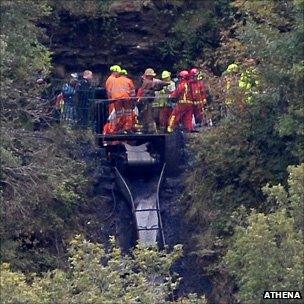Gleision Colliery near Cilybebyll: Brief history
- Published

Rescue teams at the colliery on Thursday
The Gleision Colliery, near Cilybebyll, Pontardawe opened in the 1960s.
It is a small drift mine working a coal seam from the Rhondda in a remote location cut into a hillside in the Swansea Valley.
Access to the mine is down a narrow lane on a very steep hill above the banks of the river Tawe.
It's different from the classic image of a coal mine, reached by a shaft.
"A drift mine is one that can be accessed by foot - a bit like an underground Tube station," said Wayne Thomas, official with the National Union of Mineworkers (NUM) in south Wales.
Gleision Colliery is one of just a handful of small mines left in the area. Another, Nant Hir mine in Glynneath closed in 2010.
In 1992 there were around 85 such drift mines operating but the trade has been in steep decline.
Just four small drift mines still exist in south Wales, two in the Swansea Valley, one in Neath and one in south east Wales.
A number of larger mines are still active, running bigger operations in the area.
'Far more physical method'
Across the country and throughout the world, south Wales was once famous for its mining industry.
For many hundreds of families in the area, mining was central to their lives and bound communities together.
But by the end of the 20th Century the Welsh coal industry had dwindled from its former strength.
The mine at Cilybebyll has been run off and on for five decades.

The mine is on steep hill above the banks of the River Tawe
Wayne Thomas said the rise in the price of coal and the quality of the anthracite in the local area had seen mining become more profitable in recent years and led to a "resurgence of interest".
There were two larger drift mines in the area, US and Canadian owned, one employing around 300 men and another around 160.
But the Gleision colliery is much smaller.
Mr Thomas said: "This is a small scale operation, a far more physical method of mining. There would be about 10 to 15 employees."
Typically, the miners work in 6ft high areas, boring holes to use explosives and working out the coal with shovels.
Working in such a condensed way is what gives the anthracite such a high value, Mr Thomas said.
"This does mean there are limitations to the working conditions which mean you cannot use big machinery like the old National Coal Board mines did."
Mine rescue teams confirmed that the four miners at Gleision Colliery were trapped by water after they broke into an area of old mine workings.
Mr Thomas said water in any mine would be a risk but when the mine operator applies for a licence to work a particular reserve of coal, there is a national database with records showing where that seam had been worked before.
This limits the dangers of operating in old workings, he said, and creates a boundary between the old and new collieries. It also reduces the chances of an inrush of water.
- Published15 September 2011